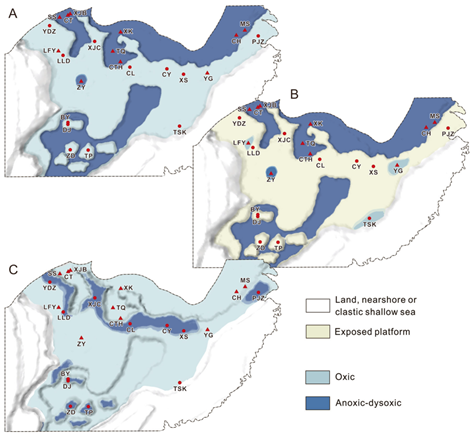Abstract
Redox variations across the Permian-Triassic boundary (PTB) have long been debated, especially during the proliferation of PTB microbialites. Here, we report redox fluctuations across the PTB to evaluate links between the two based on pyrite framboid analysis from basin to platform settings in South China. During the end-Permian extinction, abundant framboids indicate a widespread anoxia that was likely a direct cause of extinction. In the earliest Triassic (Hindeodus parvus conodont zone), pyrite framboids were absent in ramp to basin and shallow, nonmicrobialite platform sections. In contrast, the coeval microbialites yield abundant framboids indicative of dysoxia. The fact that framboids were only confined to PTB microbialites and absent in other habitats indicates that microbe bloom may have stimulated dysoxic watermass and triggered the framboid growth within microbe aggregates. Thus, microbialites were not built in reducing settings, but instead, microbial proliferation caused local, dysoxia within shallow oxygenated platforms after the extinction.
Key Points
A total of 17,306 pyrite framboids are analyzed in size and morphology from the Permian-Triassic boundary beds of 26 sections, South China
Framboids were absent in ramp to basin and shallow, nonmicrobialite platforms after the extinction, but occurred in coeval microbialites
Microbe bloom/microbialite growth was not triggered by reducing condition, but stimulated dysoxic water mass and triggered framboid growth
Zhong-Qiang Chen, Yuheng Fang, Paul B. Wignall, Zhen Guo, Siqi Wu, Ziliang Liu, Rongqin Wang, Yuangeng Huang, and Xueqian Feng. 2022. Microbial Blooms Triggered Pyrite Framboid Enrichment and Oxygen Depletion in Carbonate Platforms Immediately After the Latest Permian Extinction. Geophysical Research Letters 49, e2021GL096998. https://doi.org/10.1029/2021GL096998

Redox mapping over the P-Tr transition (from Phase 1 to Phase 3) in South China. (a)–(c) Redox maps showing spatiotemporal distributions of reducing water masses during Phases 1–3.